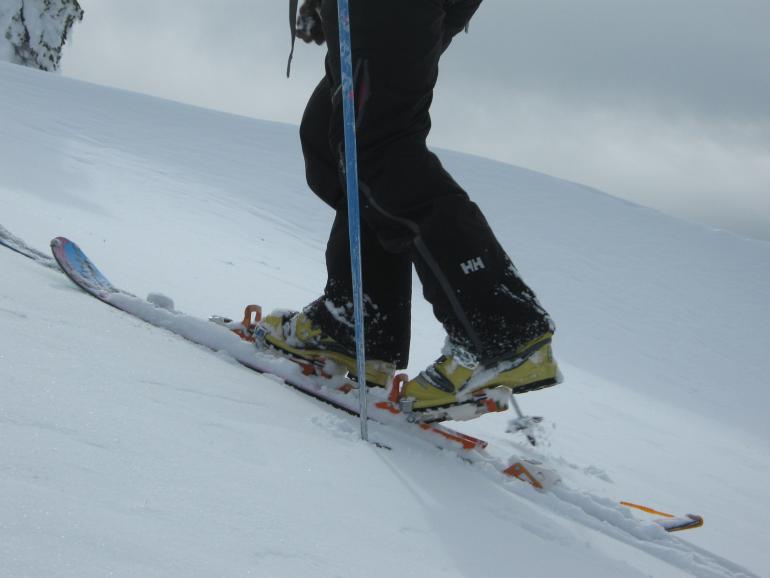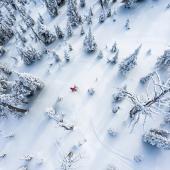Telemark Skiing 101
Free the heel, free the mind.
Telemarking is one of those things, like rock climbing or perhaps fly fishing, that can’t be easily explained to outsiders. I mean, why make skiing harder than it has to be? It may be beautiful to watch someone telemark well—the deep balanced lunges, the graceful swoosh of a transition—but you know those quads are burning. This is obviously not the easiest way down the mountain. And practically everything in modern society is geared toward making life more comfortable, not less so.
Fortunately, modern equipment and techniques have made learning to telemark much, much easier. It’s gathering all the information and sorting through the hype that takes time. With this in mind, we’ve done all the legwork for you and compressed it down to the essential elements.
THE GEAR
Ahh, new gear. This prospect alone may be reason enough to take up telemarking. There’s just nothing wrong with getting yourself a nice setup.
Boots are the most important element of any ski package. Don’t scrimp much here (well, not as much—true gearheads always scrimp a little). With tele-skiing, boot selection is easy because there are only three brands: Scarpa, Garmont, and Crispi. If your foot is narrow, go with a Scarpa. If it’s wider, try Garmont or Crispi. Now you need to pick the amount of stiffness you want in your boot. Stiffness pretty much translates into responsiveness, but also means the boot is less forgiving and certainly less comfortable for long backcountry slogs. For most beginners, a mid-flexing boot is best. The boot should be snug with light socks on; when the foam packs out, it’ll fit your regular socks just right. Take some time and try on several pairs, flexing them forward like you were skiing. Local ski shops will be able to tell you the specifics of each boot, but for a well-built and popular boot, I give a nod to the Scarpa T2 and the Garmont Veloce or Gara.
Picking out skis are where you’ll get the most opinions, information, and most likely... hype. It’s also where you have the most choices. To start, there are differences between tele skis and alpine skis. Tele skis are lighter, and flex differently because the bindings are different; but many excellent telemarkers use alpine skis. While this may be a perfectly viable option, I recommend sticking with true tele skis at first. There are, however, a few main components to consider in any ski.
Width and shape are pretty much the main determinants as to how your skis will perform underfoot. There are skinny skis (under 68mm or so at the waist), fat skis (80mm and up), and in between you’ve got mid and mid-fat. Basically, fat skis are for powder; they’re made to float through deep snow, and generally don’t hold well on hardpack. Skinny skis are generally quicker-turning, but don’t perform well in crud and deeper snow. So you need to consider the type of skiing you’ll be doing (backcountry or resort, groomers or tree runs) when choosing width and shape.
Sidecut is the relationship between the shovel (top of ski), waist (middle of ski), and tail (bottom of ski). It is the advent of "shaped skis" (way more sidecut) that has revolutionized skiing in recent years. Shaped skis turn quicker, but an overly aggressive sidecut (over 38mm) can be extremely demanding of the skier. Skis with medium sidecut are the most popular. Flex takes place in two directions: down the ski and across the ski. Softer skis are easier to ski, but don’t perform as well under adverse conditions. Stiffer skis demand better technique and more strength and energy, but return better edge-hold and speed capability. Lighter skiers generally don’t need as stiff a ski as heavier folks.
When you take all this into account, choosing a ski can seem a bit perplexing, so I’m going to risk overflowing our Letters to the Editor box and make some recommendations. For mid-weight folks that are reasonably athletic and will go into the backcountry occasionally, try the Black Diamond Mira or the Atomic TM22.
• Until you get good at tele-skiing, bindings don’t really matter that much—any decent binding will serve you well. There are basically two types: tension-spring and the newer compression-spring bindings. Tension-spring bindings are simpler; compression-spring bindings are more aggressive. Starting out, I’d recommend a basic and inexpensive binding. Try the classic Black Diamond Riva Z or Voile Riva.
As far as other gear goes, there’s not much that’s specific to tele-skiing. Run your poles a bit shorter than your alpine setup, and if you want to go uphill on your own steam, you’ll need a set of climbing skins. Skins are modern equivalents of seal skin that slide on the forward step, but grab when you kick, much like cross-country skis. You cut the skins to the shape of your ski, stick them to the bottom, and hook the tip and tail. You’ll be amazed how steeply you can climb with new skins and good technique.
WHERE TO GO
Beyond Bridger Bowl, Big Sky Resort, and Moonlight Basin—not to mention the other fantastic ski areas across Montana—there are thousands of little stashes of backcountry bliss. Ask around at the ski shops for guidance, but the only real way to find these is to get out there. Grab some friends and head for the mountains—you don’t have to drive far. Remember, if you plan to ski in the backcountry, bring avalanche gear and know how to use it.
TECHNIQUE
This is usually the thrust of an article on
learning to telemark, but I think it’s best to learn as you go. Bridger has tons of amazing tele skiers—just watch them, and maybe ask a few to give you some tips. Balance and stamina, strength and flexibility: these are certainly the basics for a good telemark skier; but good technique will trump all these. I’d highly recommend a lesson or two.
SAFETY
As with all skiing, injuries do happen. Telemark bindings don’t release, and that might be foremost in your mind if you wreck while you’re maching. ACL injuries do occur, but telemarking is said to have a much lower incidence of these than alpine skiing. Staying in a nice, aggressive stance with your weight forward reduces the chance of an ACL injury in a wreck. Again, both fitness and flexibility will help as well.
RESOURCES
Northern Lights / Rivers, Lakes & Oceans
Bozeman
Uphill Pursuits
Bozeman
Grizzly Outfitters
Big Sky
Gallatin Alpine Sports
Big Sky
Summit Bike & Ski
Bozeman












